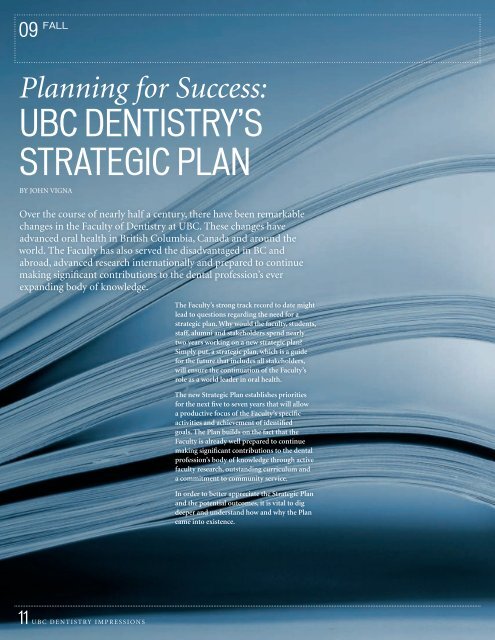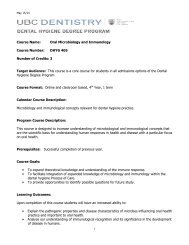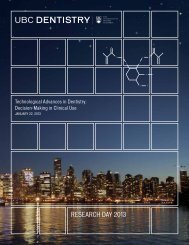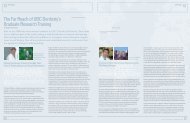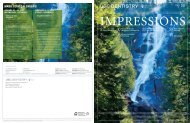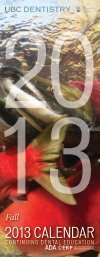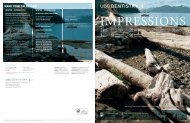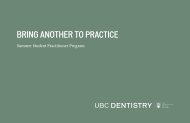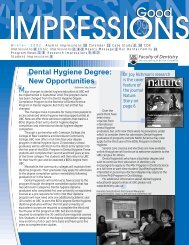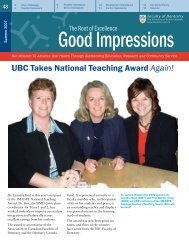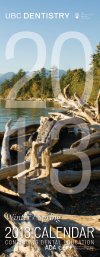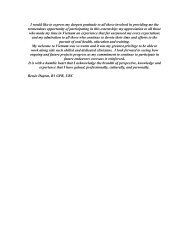UBC DENTISTRY'S STRATEGIC PLAN
UBC DENTISTRY'S STRATEGIC PLAN
UBC DENTISTRY'S STRATEGIC PLAN
Create successful ePaper yourself
Turn your PDF publications into a flip-book with our unique Google optimized e-Paper software.
09 <br />
Planning for Success:<br />
<strong>UBC</strong> DENTISTRY’S<br />
<strong>STRATEGIC</strong> <strong>PLAN</strong><br />
BY JOHN VIGNA<br />
Over the course of nearly half a century, there have been remarkable<br />
changes in the Faculty of Dentistry at <strong>UBC</strong>. These changes have<br />
advanced oral health in British Columbia, Canada and around the<br />
world. The Faculty has also served the disadvantaged in BC and<br />
abroad, advanced research internationally and prepared to continue<br />
making significant contributions to the dental profession’s ever<br />
expanding body of knowledge.<br />
The Faculty’s strong track record to date might<br />
lead to questions regarding the need for a<br />
strategic plan. Why would the faculty, students,<br />
staff, alumni and stakeholders spend nearly<br />
two years working on a new strategic plan?<br />
Simply put, a strategic plan, which is a guide<br />
for the future that includes all stakeholders,<br />
will ensure the continuation of the Faculty’s<br />
role as a world leader in oral health.<br />
The new Strategic Plan establishes priorities<br />
for the next five to seven years that will allow<br />
a productive focus of the Faculty’s specific<br />
activities and achievement of identified<br />
goals. The Plan builds on the fact that the<br />
Faculty is already well prepared to continue<br />
making significant contributions to the dental<br />
profession’s body of knowledge through active<br />
faculty research, outstanding curriculum and<br />
a commitment to community service.<br />
In order to better appreciate the Strategic Plan<br />
and the potential outcomes, it is vital to dig<br />
deeper and understand how and why the Plan<br />
came into existence.<br />
11 <strong>UBC</strong> DENTISTRY IMPRESSIONS
<strong>STRATEGIC</strong><br />
GOALS<br />
01<br />
02<br />
03<br />
Faculty and staff model the Core Values<br />
of the Faculty of Dentistry as per our<br />
Guiding Principles.<br />
Accept and graduate students who share<br />
Faculty of Dentistry Core Values as per our<br />
Guiding Principles.<br />
All undergraduate, graduate and postgraduate<br />
programs meet the highest<br />
standards of excellence and reflect<br />
community demands.<br />
07<br />
08<br />
09<br />
10<br />
Develop and maintain outstanding facilities<br />
to support students through their programs<br />
in dentistry.<br />
Increase research capacity.<br />
Develop graduate programs.<br />
Develop research support.<br />
04<br />
Encourage greater connection between <strong>UBC</strong><br />
and the external community, including the<br />
university, organized dentistry and dental<br />
hygiene, practising dentists and dental<br />
hygienists, and the greater communities of<br />
Vancouver and the province.<br />
05<br />
Develop multi-site clinical learning<br />
environments to optimize learning<br />
opportunities, better serve disadvantaged<br />
population groups and recruit the best<br />
students from all sectors of BC.<br />
06<br />
Expand the international presence at <strong>UBC</strong><br />
and <strong>UBC</strong>’s presence globally.<br />
<strong>UBC</strong> DENTISTRY IMPRESSIONS 12
09 <br />
A NEW DIRECTION<br />
Planning for the future is an important<br />
academic process. <strong>UBC</strong> president Stephen<br />
Toope is leading this process campus-wide<br />
so that everyone develops an understanding<br />
about the direction in which <strong>UBC</strong> is heading. It<br />
is important that the entire university moves<br />
forward in a coordinated way and that the<br />
Faculty of Dentistry is aligned with the <strong>UBC</strong><br />
objectives. Dean Shuler initiated the process in<br />
the Faculty of Dentistry soon after becoming<br />
dean in April 2007.<br />
“Historically, we’ve always had a strategic plan,”<br />
says Dr. Christopher Zed, associate dean for<br />
Strategy and External Development. “Every faculty<br />
is required to have one to help explain to the<br />
public what <strong>UBC</strong> is doing. But the dean came with<br />
a different strategic vision than we had before. He<br />
wanted the strategic plan to be more operational.”<br />
One of the challenges Dean Shuler inherited<br />
was that the existing strategic plan was<br />
composed primarily of a series of different<br />
goals that were loosely coordinated, which is<br />
not uncommon in most strategic plans. But<br />
more importantly, the dean recognized that<br />
sits unused in a drawer because achievement of<br />
the goals was not established by developing an<br />
operational plan.”<br />
“I went through the strategic plan that had<br />
been created before I arrived at <strong>UBC</strong> and<br />
found that the numerous short goals coalesced<br />
around three main themes: enhancing the<br />
student experience, amplifying research<br />
productivity and increasing community<br />
involvement,” he says. “There’s tremendous<br />
overlap between the three themes, but all of them<br />
relate to the fundamental goals of the Faculty<br />
and university. After identifying these three<br />
themes, the four associate deans went through<br />
the previous strategic plan, linking the original<br />
goals with one or more of the themes. To address<br />
the three main themes, overlaps between goals<br />
were found and new goals were identified to fill<br />
gaps that existed. The result was that some of the<br />
previous goals were more clearly emphasized and<br />
new ones began to emerge.”<br />
Understandably, the associate deans had many<br />
high-level, broad goals after reviewing the former<br />
strategic plan. In narrowing their list, they<br />
Eventually, the wide list of goals was narrowed<br />
down to ten strategic goals. Each goal consisted<br />
of a set of elements, including the specific goal<br />
statement, the rationale for the importance<br />
of this goal to the Faculty of Dentistry, the<br />
enabling activities that would be required<br />
to achieve the goal, the resource/budget<br />
requirements for the goal, a plan for assessing<br />
outcomes, and both interim and ultimate<br />
benchmarks. The draft of the ten strategic<br />
goals was then presented to the Appointments,<br />
Budget and Planning Committee for input and<br />
revision. The revised goals were opened up to<br />
faculty consultation in the autumn of 2008.<br />
In over a dozen meetings, the Faculty spent<br />
time discussing and revising the draft strategic<br />
goals to focus the objectives and ensure that<br />
the necessary enabling activities were recognized,<br />
that appropriate benchmarks were identified and<br />
assessment metrics established. In January 2009,<br />
the new strategic plan was presented in numerous<br />
meetings to the important Faculty stakeholder<br />
groups—including students, staff, part-time<br />
faculty, alumni and members of the profession—<br />
for consultation and critique. The plan has been<br />
“We sought content that was truly reflective of the Faculty from the three main<br />
themes,” says Zed. “We focused on the core content and stripped out the verbiage<br />
and condensed it into what and why, how do we measure it, and does it mean<br />
anything today?”<br />
the achievement of these goals needed to<br />
be defined by specific benchmarks to clarify<br />
explicitly what must be achieved to reach each<br />
goal. Benchmarks also require the development<br />
of assessment metrics that can be evaluated to<br />
measure progress towards the goal.<br />
“The development of a strategic plan often<br />
requires an enormous effort on the part of<br />
numerous individuals in the faculty,” says<br />
Shuler. “Yet, after the plan is completed, it often<br />
considered what could apply today and what could<br />
be applied in the future, and in determining the<br />
value of the goals, they asked how each goal related<br />
to others and whether there were any crossovers.<br />
“We sought content that was truly reflective of<br />
the Faculty from the three main themes,” says<br />
Zed. “We focused on the core content and<br />
stripped out the verbiage and condensed it into<br />
what and why, how do we measure it, and does it<br />
mean anything today?”<br />
refined through nearly 30 face-to-face meetings<br />
and through discussion in an online forum.<br />
“Our goal with the strategic plan was to develop<br />
a direction for the future that was understood<br />
by the people in our Faculty and resulted in<br />
intentional progress towards the goals. This will<br />
allow us to focus our energy and resources on<br />
these goals,” says Shuler. “Unfortunately, with<br />
many strategic plans, the review of achievement<br />
only occurs after several years, and progress<br />
PHOTO BY BRUCE McCAUGHEY<br />
13 <strong>UBC</strong> DENTISTRY IMPRESSIONS
09<br />
towards the goals has simply been a coincidence.<br />
The result is that resources have not been<br />
efficiently allocated and opportunities are missed.”<br />
Shuler adds, “There were two main challenges<br />
for all of us involved in completing the strategic<br />
plan: the identification of the benchmarks<br />
and the establishment of assessment metrics<br />
to measure progress towards the benchmarks.<br />
These are critical to ensure that we know<br />
where we want to be in five to seven years and<br />
plan accordingly. Most of us had experienced<br />
strategic planning processes that were more<br />
visionary than aiming for specific targets. So<br />
we had to come up with clear definitions about<br />
what we were going to do and what we were not<br />
going to do. In the end, we had to go through an<br />
enormous cultural shift to get there.”<br />
The Strategic Plan, which began in autumn 2007,<br />
is operational today and will help guide the Faculty<br />
in determining how they allocate their resources<br />
and set budgets for five to seven years. It will be<br />
incorporated as part of the overall <strong>UBC</strong> Strategic<br />
Plan and, in fact, the process followed by the<br />
Faculty of Dentistry has been adopted by <strong>UBC</strong> as<br />
the university’s Strategic Plan is being completed.<br />
“One clear thing emerged from the process:<br />
a well-defined strategic plan would be<br />
transparent and allow everyone to see how<br />
they contribute to the achievement of the goals.<br />
The plan would allow us all to be on the same<br />
page and would provide us with a touchstone<br />
to guide us in all that we do, so we know where<br />
we are going,” says Shuler. “That way, everyone<br />
can take pride in the Faculty goals and feel as if<br />
they are important to their achievement.”<br />
Enhancing<br />
THE STUDENT EXPERIENCE<br />
“The most important thing we do is teach<br />
students,” says Zed. “We want to give them<br />
the best possible education. The students<br />
have to have an experience above and beyond,<br />
relative to other choices. But to provide this,<br />
we need to have a strong triad: great educators,<br />
leading-edge researchers and highly skilled<br />
clinicians. This is what supports ‘enhancing<br />
the student experience.’ This is what produces<br />
a great learning environment for students.<br />
How do we deliver that experience? Through<br />
translational research that comes out of the labs,<br />
the classroom experience, community work<br />
and clinical experiences to name just a few.<br />
For example, if a student works in Vancouver’s<br />
Downtown Eastside in the morning and then<br />
comes to work in the main clinic at our Point<br />
Grey campus in the afternoon, they have the<br />
rich experience of working with a wide range of<br />
community members. That will only enhance<br />
their learning experience.”<br />
A major consideration in determining the<br />
metrics and benchmarks for the strategic<br />
plan revolves around the student experience.<br />
Exceptional programs are self-perpetuating—<br />
they attract top applicants and faculty, and<br />
then offer students an unparalleled experience<br />
during their time in the program. Graduates of<br />
top programs are often recognized throughout<br />
the professional community, further enhancing<br />
the reputation of the Faculty. A strategic<br />
plan supports and reinforces the curriculum,<br />
patient care, research programs and patterns<br />
of behaviour of all students, staff and faculty,<br />
creating an environment of collegiality. This<br />
enhances the student experience in a myriad of<br />
ways, including creating tomorrow’s leaders.<br />
“One of the most challenging aspects of excellent<br />
dental education is providing authentic<br />
assessment, ensuring that students meet the<br />
“One of the most challenging aspects of excellent dental education is providing<br />
authentic assessment, ensuring that students meet the stated standards of the<br />
program, but also providing them with constructive feedback about how they are<br />
doing,” says Dr. Joanne Walton.<br />
PHOTO BY BRUCE McCAUGHEY · PHOTOS BY TERRY WINTONYK<br />
<strong>UBC</strong> DENTISTRY IMPRESSIONS 14
09 <br />
stated standards of the program, but also<br />
providing them with constructive feedback about<br />
how they are doing,” says Dr. Joanne Walton,<br />
associate dean, Academic and Student Affairs.<br />
“We are interested in learning more about<br />
assessment best practices and tools. Beginning<br />
with a series of faculty ‘teaching suppers’ with<br />
eminent educators to guide us, we will reflect on<br />
how we are assessing students in the knowledge,<br />
clinical skills and professionalism domains, where<br />
we might consider development, and how we can<br />
match the quality of our student assessment with<br />
the quality of our innovative programs.”<br />
Mentorship is a key part of enhancing the<br />
student experience. Mentorship seeks to<br />
establish long-term, one-on-one relationships<br />
between future graduates and practising<br />
dental professionals. For the young graduate,<br />
entering the dental profession can be a daunting<br />
experience, and mentors can be a valuable<br />
resource. Career guidance, learning about being<br />
an associate versus an owner, and coaching in<br />
practice management are common themes in<br />
mentorship programs. Collaborations with the<br />
British Columbia Dental Association and the<br />
Study Club Alliance are opening many new<br />
opportunities for members of the profession<br />
to help mentor dental students and aid them<br />
in their transition from dental school to<br />
dental practice.<br />
“One of my goals as a clinical instructor is<br />
to motivate students,” says Dr. Maria Garcia<br />
Fulle de Owen, clinical assistant professor. “As<br />
mentors, we can encourage students to meet<br />
the highest standards of excellence in their<br />
clinical practice while helping them provide<br />
patients with the best dental treatment. This<br />
connection between instructors and students<br />
is the most important factor in our job as<br />
mentors.” Faculty mentoring behaviour also<br />
leads students to become peer mentors, further<br />
emphasizing this role.<br />
“What motivates me to be a leader is the<br />
satisfaction of moving ideas forward and<br />
getting things accomplished,” says secondyear<br />
dental hygiene student Priscilla Ojeda,<br />
founding president of the Dental Hygiene<br />
Class of 2011. Priscilla also represents her<br />
class in the Dental Undergraduate Society, a<br />
collaborative society that links dental and<br />
dental hygiene students together. “I intend to<br />
continue assisting the incoming students in my<br />
program by paving the way as the pioneer; by<br />
unifying my program with the other programs<br />
in the Faculty, as well as connecting them with<br />
the broader <strong>UBC</strong> community,” she says. “I<br />
want to contribute to others what hadn’t yet<br />
been developed for me.”<br />
Amplifying RESEARCH PRODUCTIVITY<br />
“The Strategic Plan gives the Faculty specific directions that we,<br />
and the greater community, see as important,” says Putnins.<br />
The Strategic Plan takes into account that<br />
<strong>UBC</strong> is a major research-intensive university.<br />
Therefore, there is an expectation that all<br />
faculties will have an emphasis on original<br />
research in their portfolio of activities. This<br />
expectation, “the generation of new knowledge,”<br />
is a critical area of accomplishment for all faculty<br />
members who are reviewed for tenure and<br />
promotion. Thus it is critical for the Strategic<br />
Plan to ensure that a firm foundation for<br />
continued excellence in research is recognized<br />
and supported by a diversity of research (basic<br />
science, population health and clinical trials)<br />
being done within the Faculty of Dentistry.<br />
“Research and graduate studies are targeted in<br />
the Strategic Plan and are very specific,” says<br />
Dr. Edward Putnins, associate dean of Research,<br />
Graduate and Postgraduate Studies. “Our<br />
challenge in putting the Plan together was to<br />
determine what is required to most effectively<br />
support a diverse Faculty. How do we measure<br />
it? Increasing research capacity will be assessed<br />
by multiple measures that could include more<br />
research-active faculty, more research space,<br />
more grants, more high-impact publications<br />
and greater research eminence.”<br />
The high level of research activity will also help<br />
address the recognized shortage of dental and<br />
dental hygiene academics. It is critical to prepare<br />
the next generation of dental faculty members<br />
with training at the PhD, clinical specialty or<br />
combined levels. The development of these<br />
programs will achieve the long-term goals<br />
of dental academic institutions and help students<br />
who are interested in developing a balanced<br />
academic career of research, service and teaching.<br />
Expansion of specialty programs to encompass<br />
all recognized disciplines will also enable more<br />
complex delivery of treatment and will support<br />
the clinical educational continuum such that<br />
undergraduate students will be able to observe<br />
a full range of treatment provided to patients<br />
with complex craniofacial disorders. The dental<br />
specialty programs represent a critical intersection<br />
for new research knowledge and translation of that<br />
knowledge to improvements in patient outcomes.<br />
“The Strategic Plan gives the Faculty specific<br />
directions that we, and the greater community,<br />
see as important,” says Putnins. “The Plan<br />
is interrelated and interactive. It helps the<br />
community understand how all the pieces fit<br />
together so that everyone is more inclined to<br />
support it. The biggest challenge in the process<br />
was to make sure the final document included<br />
the diversity of the research being done in the<br />
Faculty. For the Plan to be of lasting, real value,<br />
every faculty member should be able to read it<br />
and see parts they relate to, parts where they see<br />
themselves fitting in.”<br />
15 <strong>UBC</strong> DENTISTRY IMPRESSIONS
09<br />
Increasing COMMUNITY INVOLVEMENT<br />
Putting together the Strategic Plan involved a<br />
significant collegial process, one in which each<br />
faculty member, student, staff, alumni and<br />
stakeholder found goals that they could relate<br />
to and contribute additional comments to. The<br />
more feedback there was, the richer the ideas. The<br />
richer the ideas, the more inclusive and visionary<br />
the strategic plan became.<br />
“From a community perspective, it was wonderful<br />
to realize how many economies there are within<br />
the Faculty,” says Zed. “We ended up merging<br />
some of our goals through this realization. Even<br />
though we all work together every day, we don’t<br />
always understand what our colleagues do and<br />
what significant experiences and skills they all bring<br />
to the Faculty. The strategic plan process helped<br />
us understand and better appreciate one another.<br />
Without a doubt, ‘community’ was the most<br />
collaborative part of the plan.”<br />
The Faculty continually expands its offerings, such<br />
as a symposium on digital learning that facilitates<br />
collaborations among dental personnel throughout<br />
Canada and California, and a pediatric dentistry<br />
program. Programs such as these provide resources<br />
to the community and enhance the Faculty’s<br />
reputation as a centre of not only educational and<br />
research excellence, but also of clinical excellence<br />
throughout BC, Canada and internationally.<br />
“One of the things I’m most excited about in the<br />
Plan is that I’ve been able to strike a community<br />
advisory committee with members from across<br />
the community,” says Zed. “We are looking at<br />
community programs and how we may serve as<br />
a resource the community goes to for oral health<br />
care. By working as a committee, we are able to<br />
have a better around-the-table discussion and<br />
work more effectively, more broadly. We owe this<br />
to the strategic plan process.”<br />
Service learning and cultural competency are<br />
rapidly emerging and developing concepts in<br />
dental and dental hygiene education. Important<br />
outcomes from these experiences include<br />
student recognition of their responsibility to<br />
provide care to people in need, social awareness<br />
and professional responsibility. More offcampus<br />
sites for current and future students will<br />
increase the diversity of patients treated by the<br />
students and enhance students’ understanding<br />
of the range of oral health needs presented by<br />
individuals with limited access to care.<br />
“One goal is to be of service to families and<br />
individuals who work or attend school on<br />
weekdays,” says professor Bonnie Craig,<br />
director of the Dental Hygiene Degree<br />
Program at <strong>UBC</strong> Dentistry.<br />
“We want students to develop increased social<br />
responsibility and a commitment to community<br />
service, and to do so they need to experience a<br />
diverse patient population. One way to achieve<br />
this is by reaching out to address some of the<br />
unmet needs of the community—those whose<br />
life circumstances may prevent them from<br />
coming during regular business hours.”<br />
Trevor Lake, a member of the Class of 2009,<br />
had an opportunity to complete an externship<br />
in Haida Gwaii (Queen Charlotte Islands) last<br />
summer. “This experience felt like we were finally<br />
putting the things we had learned at <strong>UBC</strong> into<br />
action,” he says.<br />
Lake felt his externship was a natural<br />
continuation of his education; one that he says<br />
has ultimately shaped the way he intends to<br />
practise in the future. “One of the main reasons<br />
I got into dentistry is that I wanted to be able<br />
to provide health care to people in need. My<br />
experience confirmed that it is always important<br />
to stay true to your values and remember that the<br />
core goal of our profession is to improve the oral<br />
health of all members of our society. My time in<br />
Haida Gwaii also reinforced my plans to practise<br />
dentistry in a rural community.”<br />
Looking TO THE FUTURE<br />
“Through the intensive collaborative process, the Faculty has undergone<br />
a cultural shift to the point where the Strategic Plan is now linked to our<br />
activities in recruitment, renovation, budget allocation and new program<br />
development,” says Shuler.<br />
“The Strategic Plan is now in effect,” says Dean<br />
Shuler. “We can point back to the Plan and rely<br />
on it as support for our goals and objectives,<br />
and in doing so, we can see where and how we<br />
fit into the whole.”<br />
During the last two years, the process of<br />
strategic planning has further strengthened<br />
the ties between the Faculty and their alumni,<br />
external partners, current and future students.<br />
“Through the intensive collaborative process,<br />
the Faculty has undergone a cultural shift<br />
to the point where the Strategic Plan is<br />
now linked to our activities in recruitment,<br />
renovation, budget allocation and new<br />
program development,” says Shuler.<br />
“We all have ownership and responsibility<br />
in it, and we should be held accountable for<br />
those responsibilities.”<br />
By presenting shared beliefs about where<br />
they are headed, the Faculty has created a<br />
collaborative road map that is conceptual,<br />
directional and, most importantly, operational,<br />
to lead them into the next decade.<br />
The complete Faculty of Dentistry Strategic<br />
Plan and its Guiding Principles are available<br />
online at www.dentistry.ubc.ca/strategicplan.<br />
PHOTOS BY BRUCE McCAUGHEY<br />
<strong>UBC</strong> DENTISTRY IMPRESSIONS 16
09 <br />
Guiding<br />
PRINCIPLES<br />
MISSION<br />
OPERATIONAL GOAL<br />
ESSENTIAL CUSTOMERS<br />
AND PARTNERS<br />
ULTIMATE RESULTS SOUGHT<br />
CORE IDEAS<br />
for the successful achievement of<br />
Ultimate Results Sought<br />
CORE VALUES<br />
that support our Core Ideas<br />
To advance oral health through outstanding<br />
education, research and community service.<br />
To develop an exceptional Faculty of Dentistry<br />
at <strong>UBC</strong> worthy of enthusiastic support by our<br />
customers and partners.<br />
· Students<br />
· Faculty and Staff<br />
· <strong>UBC</strong> Community<br />
· Alumni<br />
· Patients, Public, Community<br />
· Funders, Donors<br />
· Related Health Organizations<br />
· Teaching Agencies<br />
· Research Agencies<br />
· Related Professional Organizations<br />
· Related Industry<br />
· Well-educated graduates who are ably<br />
prepared to meet the oral health and science<br />
needs of their communities.<br />
· Innovative research that has a positive<br />
impact on oral health science, education and<br />
patient care.<br />
· Enthusiastic customers and partners who<br />
want to join and support our efforts.<br />
· Provide exceptional undergraduate education.<br />
· Offer high-quality graduate and postgraduate<br />
programs.<br />
· Develop research capacity through<br />
collaboration, concentration and<br />
career development.<br />
· Offer relevant continuing dental education.<br />
· Conduct timely and effective communication<br />
with all of our customer groups.<br />
· Cultivate a diversified funding base to support<br />
the Faculty.<br />
· Define and monitor results.<br />
· Support individual enterprise while<br />
fostering collaboration.<br />
· Exemplary professionalism (teaching, clinical<br />
care, research, administration).<br />
· Mindful service to our customers and partners.<br />
· Shared responsibility for the faculty’s welfare<br />
and financial health.<br />
· Thoughtful, timely communication.<br />
· High degree of collaboration, partnership<br />
and dialogue.<br />
· Results-oriented efforts (appropriate planning,<br />
methodology and evaluation).<br />
17 <strong>UBC</strong> DENTISTRY IMPRESSIONS


